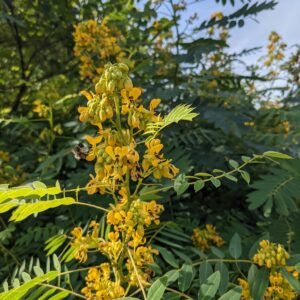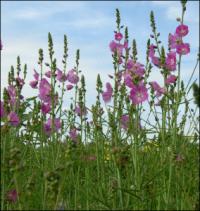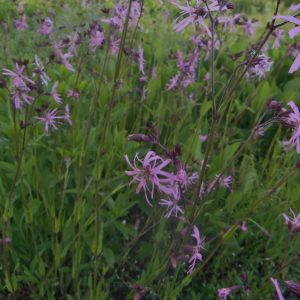Plants for Butterflies and Other Pollinators
Showing 169–176 of 211 results
-
Scutellaria altissima Somerset skullcap Z 4-10
In early summer masses of upright stems bearing bi-colored, bluish-purple and white, snapdragon-like flowers, the hood being bluish-purple and the lower lip white. Flowers grow on one side of the spike. This will re-bloom if you cut the flowers.
In early summer masses of upright stems bearing bi-colored, bluish-purple and white, snapdragon-like flowers, the hood being bluish-purple and the lower lip white. Flowers grow on one side of the spike. This will re-bloom if you cut the flowers.
Size: 24-36” x 18-24”
Care: sun to part shade in moist well-drained to well-drained soil
Native: central & eastern Europe
Wildlife Value: pollen and nectar attracts bees and butterflies1st described and named in 1700 by Joseph Pitton Tournefort, French botanist.
-
Scutellaria baicalensis Chinese skullcap Z 4-8
Many stemmed clump, the top third of each stem bears one-sided ladders of rich purple flowers, from a tube connected to the stem opening into two petal-like hoods, one above the other, the top all purple and the bottom purple with a white blotch the shape of a handlebar mustache. This beauty blooms summer into fall.
OUT OF STOCK
Many stemmed clump, the top third of each stem bears one-sided ladders of rich purple flowers, from a tube connected to the stem opening into two petal-like hoods, one above the other, the top all purple and the bottom purple with a white blotch the shape of a handlebar mustache. This beauty blooms summer into fall.
Size: 12” x 12”
Care: sun in moist well-drained soil
Native: eastern Asia, Siberia
Wildlife Value: rabbit resistantLinnaeus’ imaginative mind named this genus after the Latin sculellum meaning “a little dish,” because of its resemblance to the flower’s helmet-shaped petal-like calyx. Used medicinally since ancient times in China to cure colds, fever, headaches, and insomnia.
-
Scutellaria incana syn. Scutellaria canescens, Scutellaria villosa Downy skullcap Z 4-9
Flowers of spikes of purple-blue tubes ending in two open lips, the lower lip having a white blotch, blooming for months from July to September, if deadheaded
Flowers of spikes of purple-blue tubes ending in two open lips, the lower lip having a white blotch, blooming for months from July to September, if deadheaded
Size: 2-3’ x 12-18"
Care: sun to part shade in moist well-drained to well-drained soil. Reblooms if deadhead after 1st flush of flowers
Native: NY to WI, Georgia to TX, Wisconsin native
Wildlife Value: Deer resistant. Its nectar feeds small butterflies, Bumblebees and Hummingbirds.The name Scuttelaria is from Latin scutella meaning a small dish or saucer referring to the shape of the persistent calyx, a covering at the flower’s base. Incana means grey referring to the tiny hairs on stems and undersides of leaves giving a greyish color. Named by Johann Friedrich Theodor Biehler, German botanist from the plant specimens in Christian Sprengel’s (1750-1816) herbarium in 1807. How did German botanist Sprengel, who never set foot in America, come to have a pressed specimen of this native American plant? Sprengel and German botanist, minister and college president, Carl Ludwig Willdenow (1765-1812) were close collaborators. Another German botanist Heinrich Ernst Muhlenberg (1753-1815), living in Lancaster Pennsylvania, sent many American plants specimens to Willedenow. Scutellaria incana is native to and grows in what is now called Muhlenberg Meadow in Lancaster County PA. These connections make it likely that the specimen Biehler saw came from Henry Muhlenberg.
-
Scutellaria resinosa syn. Scutellaria wrightii Prairie skullcap Z 4-9
Two-lipped, deep violet-blue tubes bloom from spring to fall
Two-lipped, deep violet-blue tubes bloom from spring to fall
Size: 10” x 10”
Care: sun to part shade in well-drained to moist well-drained soil, drought tolerant
Native: Colorado, NM, KS, Oklahoma, TX, collected on the Canadian River, tributary of Arkansas River
Wildlife Value: deer & rabbit resistant. Nectar and pollen attract butterflies and bees.Described by botanist John Torrey in Annals of the Lyceum of Natural History of NY 2: 232 (1828)
-
Senna hebecarpa syn. Cassia hebecarpa Wild senna Z 3-8
Six inch long taxicab yellow flower clusters along the stem in July – August
Six inch long taxicab yellow flower clusters along the stem in July – August
Size: 4’ x 2-6’
Care: full sun in moist well-drained soil
Native: all North America east of Mississippi River from Hudson Bay south to Georgia and Tennessee, Wisconsin native
Wildlife Value: attracts bumble bees and wasps. A legume – it adds nitrogen to the soilCollected by 1753.
-
Seseli gummiferum Moon carrot Z 5-9 self-seeding biennial or short-lived perennial.
Five-inch diameter mound of many circles of pale pink to white flowers atop silvery, frilly, fern-like foliage flowering in mid-summer into early fall.
Five inch diameter mound of many circles of pale pink to white flowers atop silvery, frilly, fern-like foliage flowering in mid-summer into early fall.
Size: 2-3’ x 12-18”
Care: Sun to part-shade in well-drained to moist well-drained soil
Native: Crimea, Turkey and South Aegean
Wildlife Value: Deer resistant. Butterfly magnet; host for caterpillar of Eastern swallowtail butterfly.Seseli is an ancient Greek name of an umbelliferous plant. This species first described by Linnaeus in 1735. Re classified and renamed in 1830 in Prodromus systematis naturalis regni vegetabilis, sive, Enumeratio contracta ordinum generum specierumque plantarum huc usque cognitarium, juxta methodi naturalis, normas digesta.
-
Sidalcea malvaeflora Checker bloom Z 5-9
Bright pink mallow type blooms looking like a miniature hollyhock.
Bright pink mallow type blooms looking like miniature hollyhock.
Size: 2-3' x 10"
Care: sun to part shade in well-drained soil
Native: western No. America
Wildlife Value: Attracts large white skipper butterflies.Sidalcea is the conjunction of sida and alcea. Collected by Mexican botanist José Moziño around 1790 while on the Expedición Real de Botánica, probably in today’s Southern California.
-
Silene flos-cuculi syn. Lychnis flos-cuculi Ragged robin Z 4-9
May-June, cotton-candy pink star shaped of thin petals as if a bursting star.
May-June, cotton-candy pink star shaped of thin petals as if a bursting star.
Can not ship to: Connecticut and Maryland.
Size: 30” x 32”
Care: Sun to part shade, moist well-drained soil
Native: Europe, Caucasus, Russia
Wildlife Value: Butterfly plant, attracts Small Pearl Bordered Frilillary and Common BlueFlos is Latin for “flower.” According to Parkinson (1629) Ragged robin was used to cure wounds as early as Roman times. Grown by Washington at Mount Vernon. In 1851 Breck called the Ragged robin “an old inhabitant of the flower garden.”






